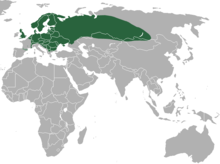Common shrew
| Common shrew | |
|---|---|
 |
|
| Common shrew (Sorex araneus) | |
| Scientific classification | |
| Kingdom: | Animalia |
| Phylum: | Chordata |
| Class: | Mammalia |
| Order: | Eulipotyphla |
| Family: | Soricidae |
| Genus: | Sorex |
| Species: | S. araneus |
| Binomial name | |
|
Sorex araneus Linnaeus, 1758 |
|
 |
|
| Common shrew range | |
The common shrew (Sorex araneus) or Eurasian shrew is the most common shrew, and one of the most common mammals, throughout Northern Europe, including Great Britain, but excluding Ireland. It is 55–82 millimetres (2.2–3.2 in) long and weighs 5–12 grams (0.2–0.4 oz), and has velvety dark brown fur with a pale underside. Juvenile shrews have lighter fur until their first moult. The common shrew has small eyes, a pointed, mobile snout and red-tipped teeth. It has a life span of approximately 14 months.
Shrews are active day and night, but mostly after dark. They are active most of the time, resting for only a few minutes between bursts of activity.
The common shrew is found in the woodlands, grasslands, and hedgelands of Britain, Scandinavia, and Eastern Europe. Each shrew establishes a home range of 370–630 square metres (440–750 sq yd). Males extend these boundaries only during breeding season, to find females. The common shrew is extremely territorial and becomes aggressive when another shrew enters its home range. It makes its nest underground or under dense vegetation.
The shrew's carnivorous and insectivorous diet consists mostly of insects, slugs, spiders, worms, amphibians and small rodents. Shrews need to consume 200-300% of their body weight each day in order to survive. A shrew must eat every two to three hours to achieve this goal. This means that a shrew may starve if it finds no food for as little as 5 hours. They do not hibernate in the winter months because their bodies are too small to hold sufficient fat reserves.
Shrews have poor eyesight, but use their excellent sense of smell and good hearing to locate food. Using these senses, a shrew can locate prey up to 12 centimetres (5 in) deep in the soil.
...
Wikipedia

